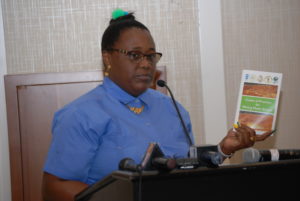By Jarryl Bryan
The Government has begun consultations with key stakeholders in the mining industry, even as it prepares to officially publish an extensive code of conduct aimed at holding miners accountable for unsafe operations and destruction of the environment.
On Tuesday, the Natural Resources Ministry-hosted consultations began at the Marriott Hotel. In her address to attendees, Minister within the Natural Resources Ministry, Simona Broomes informed them that Government was toughening its stance against delinquent miners.

Claiming that the mining sector had been run like the “Wild West”, she urged participants to get themselves familiar with the code. The code constituted the dos and don’ts of mining, aimed at mitigating the environmental damage mining caused.
“Moving into a green economy and green mining, it’s very important that all of us hold ourselves accountable and responsible for what we do. The code of practice can only be a code of practice if it is agreed upon, and that is why you are here, and if it is being enforced. And when it is enforced, you practise it.”
Legal Advisor to the Guyana Geology and Mines Commission, Kara Duff Yehudah, explained that the codes were a simplified version of the Mining Amendment Act of 2005. But in this Act, the GGMC is mandated by law to publish the codes.
“Regulation 248 states that the commission shall approve or publish a code of practise for environmental mining which shall specify the requirements for mining activities on private and public lands,” she said.
“The codes include provisions for waste management and disposal systems, mechanisms for sediment losses, effluent and contaminated drainage and emergency response plans, mine reclamation and closure plan, environment effects monitoring plans, sand and loam mining, quarrying and control flows from lower dams less than six metres in height.”
The codes also address the need for miners to have contingency and response plans.
Among those present were representatives of the mining syndicates. Mining syndicates were developed after the Natural Resources Ministers met with miners in January 2016. The decision was made to cluster small miners across the mining districts for them to benefit from concessions and support each other, something they were unable to achieve mining on their own.



